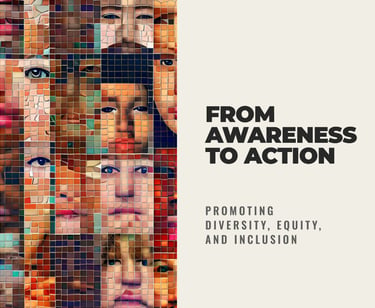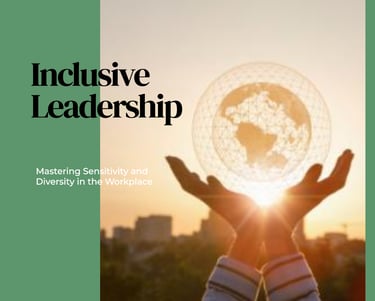Breaking Age Barriers: How to Foster Inclusion in Leadership Roles
Explore the complexities of ageism in leadership with this comprehensive guide. Dive into stereotypes affecting young and old leaders, understand how ageism limits career progression, and discover actionable solutions for a more inclusive leadership landscape. Featuring expert opinions, real-world examples, and a commentary by Certified Leadership Coach Lori Pritchard.
9/15/20236 min read


Breaking Age Barriers: How to Foster Inclusion in Leadership Roles
Ageism in leadership is a pervasive and often overlooked issue that affects leaders across various industries and organizational levels. Whether you're a young leader facing stereotypes of inexperience or an older leader contending with assumptions about your adaptability, ageism can significantly limit your career progression and opportunities. This article aims to shed light on the multifaceted nature of ageism, exploring the stereotypes affecting leaders of different age groups, the systemic barriers that perpetuate these biases, and actionable solutions for fostering a more inclusive leadership landscape. By delving into real-world examples, expert opinions, and relevant case studies, we offer a comprehensive guide to understanding and combating ageism in leadership.
Sarah: Breaking Age Stereotypes in Tech
The Stereotypes Affecting Young and Old Leaders
Young Leaders: The Double-Edged Sword of Youth
Young leaders often find themselves in a paradoxical situation. On one hand, they are praised for their fresh perspectives and innovative approaches. On the other, they face stereotypes such as being "inexperienced," "naive," or "impulsive." These labels can hinder their career growth and limit their opportunities for leadership roles, as they are often passed over for more 'seasoned' candidates.
Testimonial: "As a 25-year-old CEO, I often find my ideas dismissed simply because of my age. It's frustrating to be seen as a 'kid' when I've worked hard to get where I am." - Sarah, Tech Entrepreneur
Expert Opinion: "The stereotype of young leaders as inexperienced often overlooks their ability to adapt and innovate, qualities that are essential in today's fast-paced business environment." - Dr. John Maxwell, Leadership Expert

Older Leaders: The Challenge of Changing Perceptions
Older leaders face a different set of challenges. While they are often respected for their experience and wisdom, they also have to contend with stereotypes like being "outdated," "less adaptable," or "resistant to change." These assumptions can lead to them being sidelined in favor of younger leaders who are seen as more in tune with modern trends.
Testimonial: "At 60, I was told that the company is looking for 'fresh energy,' a polite way of saying they wanted someone younger. It's disheartening to think that my years of experience are seen as a liability rather than an asset." - Robert, Former Executive
Expert Opinion: "The stereotype that older leaders resist change can be damaging. Many older leaders are, in fact, quite adaptable and bring a wealth of experience that can benefit an organization." - Simon Sinek, Author and Leadership Consultant

Sarah: Breaking Age Stereotypes in Tech
Diversity, Equity, and Inclusion Course:
A Tool for Combating Ageism
How Ageism Limits Career Progression: The Invisible Ceiling and the Forgotten Potential
Ageism doesn't just affect individuals; it has a ripple effect that impacts organizational diversity, effectiveness, and profitability. The limitations imposed by age-related stereotypes create an invisible ceiling for young leaders and a forgotten potential for older leaders.
The Invisible Ceiling for Young Leaders
Young leaders often hit an "invisible ceiling," where their age becomes a barrier to higher-level positions. This limits their career growth and deprives organizations of fresh perspectives that could drive innovation.
Case Study: TechStart Inc. overlooked a 28-year-old CTO for a major project in favor of a less qualified but older colleague. The project faced delays and cost overruns, highlighting the detrimental effects of ageism.
Statistics: According to a Harvard Business Review study, only 23% of leaders under the age of 30 feel their organizations fully capitalize on their skills.


The Forgotten Potential of Older Leaders
Older leaders, on the other hand, often face a "forgotten potential" scenario. Their experience and wisdom are overlooked in favor of what is perceived as the "fresh energy" of younger leaders. This forces many into early retirement and robs organizations of valuable experience.
Case Study: Company X forced its 55-year-old CFO into early retirement to face financial mismanagement under the new, younger CFO.
Statistics: A study showed that 40% of leaders over the age of 50 have faced age-related discrimination, limiting their career progression and forcing many into early retirement.
Expert Opinion: "Ageism in leadership can lead to a significant loss of institutional knowledge and experience, which are irreplaceable assets," says Peter F. Drucker, Management Consultant.
Solutions to Combat Ageism: A Multi-Faceted Approach
Ageism is a complex issue that requires a multi-faceted approach to address effectively. Here are some actionable solutions that can help break down age-related barriers in leadership.
Course: Inclusive Leadership: Mastering Sensitivity and Diversity in the Workplace
Transparent Hiring Policies
One of the most effective ways to combat ageism is through transparent hiring policies focusing on skills and qualifications rather than age.
Real-world Example: Company A implemented a blind recruitment process, removing age and other demographic information from resumes, leading to a more diverse leadership team.
Expert Opinion: "Transparent hiring policies can level the playing field and allow for a more diverse range of leaders," says Frances Frei and Anne Morris, authors of "Unleashed."
Sensitivity Training
Sensitivity training can help employees at all levels understand the unconscious biases they may hold, including age-related ones.
Real-world Example: Company B introduced mandatory sensitivity training that resulted in a 30% decrease in age-related complaints within the organization.


Expert Opinion: "Awareness is the first step towards change. Sensitivity training can be a powerful tool in combating ageism," says Brene Brown, author of "Dare to Lead."
Mentorship Programs
Creating mentorship programs that pair younger and older leaders can foster mutual understanding and break down age-related stereotypes.
Real-world Example: TechStart Inc. introduced a mentorship program that led to increased collaboration and innovation across age groups.
Expert Opinion: "Mentorship can serve as a bridge between generations, allowing for the exchange of ideas and experiences," says Stephen R. Covey, author of "The 7 Habits of Highly Effective People."
Inclusive Leadership
Leaders themselves can set the tone by practicing inclusive leadership that values contributions from team members of all ages.
Real-world Example: Company C's CEO regularly holds "All Ages" town halls to discuss age-related issues and solutions.
Expert Opinion: "Inclusive leadership can create a culture where age is just a number, and everyone's contributions are valued," says Stefanie K. Johnson, author of "Inclusify."
Conclusion and Call to Action
Ageism in leadership is a complex issue that requires multi-faceted solutions. By being aware and taking proactive steps, we can create a more inclusive and effective leadership landscape.
Call to Action: If you've experienced or witnessed ageism in leadership, it's time to take action. Share this article to raise awareness and start a conversation in your organization today. Together, we can create more inclusive leadership environments.
Leadership Coach's Commentary: Breaking the Age Barrier in Leadership
By Lori Pritchard, Certified Leadership Coach
The Systemic Nature of Ageism
Ageism in leadership is not just an individual problem; it's a systemic issue that requires collective action. Young leaders can bring fresh perspectives, while older leaders offer invaluable experience. The key is to create an environment where both can thrive.
Expert Insight: "Leaders Eat Last" by Simon Sinek emphasizes the importance of creating a safe environment where everyone feels valued. This principle is crucial in combating ageism.
The Meta Position: A Higher-Level Perspective
Taking a Meta Position allows us to step back and view the issue of ageism from a higher-level, more objective perspective. This enables us to identify the underlying systemic issues and work towards holistic solutions.
Expert Insight: "The Effective Executive" by Peter F. Drucker highlights the importance of taking a step back to analyze complex issues, a principle that aligns well with the meta-position approach.
The Power of Inclusive Leadership
Inclusive leadership, as discussed in "Dare to Lead" by Brene Brown, is about embracing the full spectrum of human diversity, including age. Leaders who practice inclusivity are more likely to break down age-related barriers.
Expert Insight: "Inclusify" by Stefanie K. Johnson offers practical steps for leaders to create a more inclusive environment, which is essential in combating ageism.
The Role of Emotional Intelligence
Understanding and managing one's own emotions, as well as those of others, is crucial in breaking down age-related stereotypes. Emotional intelligence can serve as a bridge between different age groups within an organization.
Expert Insight: "How to Win Friends and Influence People" by Dale Carnegie provides timeless advice on understanding human behavior, which is key in addressing age-related biases.
Final Thoughts
Breaking the age barrier in leadership is not just about changing policies; it's about shifting mindsets. As we move towards a more inclusive future, it's crucial for leaders of all ages to come together and address this issue head-on.
Expert Insight: "The 21 Irrefutable Laws of Leadership" by John C. Maxwell emphasizes that effective leadership is about influence, not authority. Changing mindsets is the first step in influencing systemic change.



